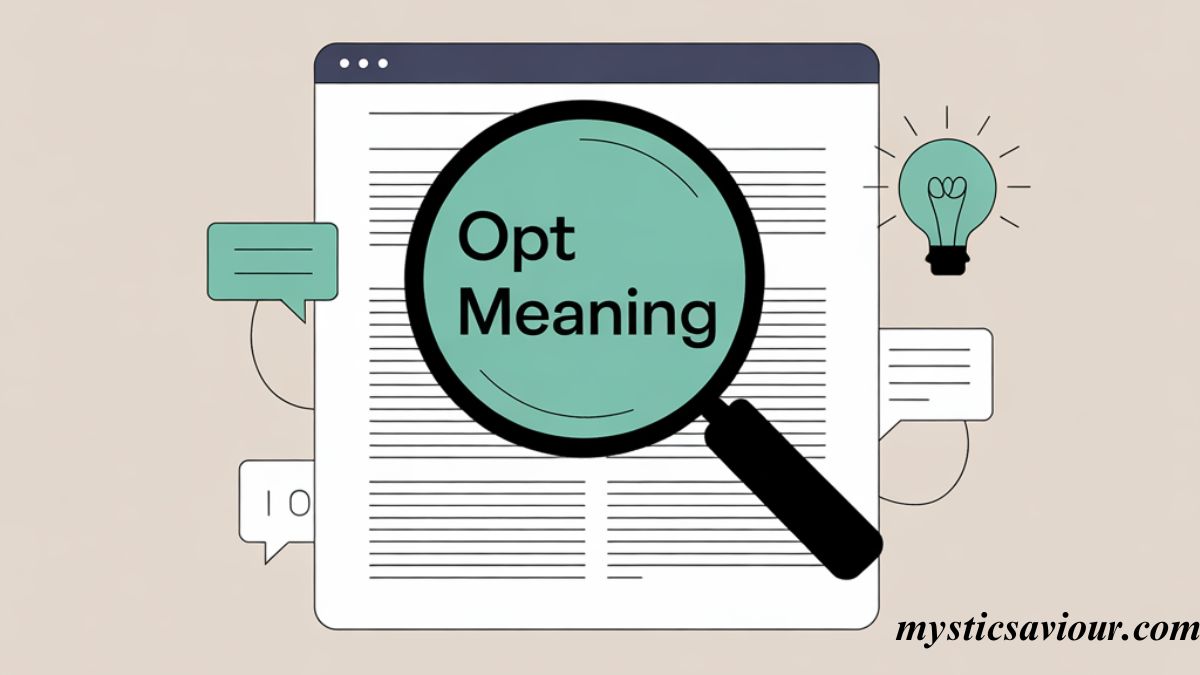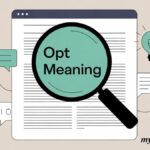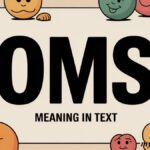The phrase “OPT meaning in text” refers to how the word opt is used in digital communication to express choice or preference. In simple terms, OPT means “to choose” or “to decide between options.” It’s often seen in messages like “Reply YES to OPT-IN” or “Text STOP to OPT-OUT,” where users grant or withdraw permission to receive marketing texts, notifications, or alerts.
In today’s digital age, understanding small terms like OPT makes a big difference. A single word can determine whether you join a community, subscribe to updates, or avoid scams. As online communication grows faster and more personalized, these abbreviations shape how people interact, engage, and respond in both casual and professional contexts.
This guide breaks down the real-world meaning, usage, and impact of OPT in text—from marketing practices to everyday messaging—so you can communicate clearly, confidently, and safely in any digital conversation.
What Does “OPT” Mean in Text?
At its core, opt is a verb meaning to choose or make a decision. You can look it up in the dictionary: “to make a choice; especially: to decide in favor of something.”
In texting, it often shows up as part of OPT-in or OPT-out, referring to whether someone agrees to receive something (like messages) or declines. But it also appears in more casual ways—to offer flexibility, not to force. Think of opt as a linguistic tool that signals choice.
Primary Meanings of “OPT” Explained
In Marketing or Professional Contexts
- OPT-in: When someone chooses to subscribe, giving permission for promotional or informational texts, emails, or notifications. For example: “Reply YES to OPT-IN for updates.” In many jurisdictions, businesses must get explicit consent before sending marketing texts.
- OPT-out: The flip side. It means a subscriber wants to stop receiving messages. You’ll often see: “Text STOP to OPT-OUT.” It’s also a legal requirement in many places to allow users to withdraw consent.
Businesses often use double opt-in, where, after initial sign-up, they ask users to confirm (via a “YES” reply or link). That extra step helps weed out accidental or fraudulent subscriptions.
In Everyday Texting or Chats
“OPT” also shows up in casual texting—less often, but naturally. For instance, someone might write:
“You can opt to join later.”
“I’ll opt for the red dress.”
Here, opt acts like “choose.” It’s not slang, just a concise way of expressing choice or permission.
Some people also use OPT to mean “optional” (synonym: up to you). For example:
“Meeting today is OPT—you don’t have to come.”
This usage isn’t formal, but it’s growing in informal digital speech.
Where You’ll Commonly See “OPT” Used
| Context | Meaning / Purpose | Sample Usage |
|---|---|---|
| Marketing / SMS | Granting or withdrawing consent | “Reply YES to OPT-IN for deals.” |
| Email / Web Forms | Choosing subscription preferences | “Check this box to opt in.” |
| Professional Chat / Work | Expressing preference or decision | “I’ll opt for Plan B.” |
| Casual Texting / Chats | Offering optional participation or choice | “You can opt to skip the meeting.” |
| Making a decision or skipping an option | Making a decision or skip option | “I opt to sit this round out.” |
🤔 Note: While “OPT” appears in group chats or gaming, it’s less common. People tend to stick with simpler words like “choose,” “go with,” or “skip.”
Real-World Examples (No Forced Slang)
Below are real conversational snippets where OPT and its variants appear. They don’t feel forced—they sound like natural speech.
Marketing / Professional Use
Business: “To receive weekly alerts, reply YES to OPT-IN.”
User: “I’ll opt in—but only for weekend deals.”
Business: “Text STOP anytime to OPT-OUT.”
Group Chat / Casual
Friend A: “Dinner tonight is OPT. You can skip if you prefer.”
Friend B: “Thanks—I’ll opt out. I’ve got other plans.”
Work / Team Chat
Manager: “We’re picking one of two templates. I’ll opt for A unless alternate votes.”
Teammate: “I opt for B. Easier layout.”
In each case, OPT smoothly replaces “choose/opt to” without changing tone.
How to Respond Naturally When You See “OPT”
Casual Replies
When someone uses OPT in a relaxed setting, your responses should feel natural—not stiff.
- “Cool, I’ll opt in.”
- “I prefer to opt out this time.”
- “I’ll opt to drop that option.”
- “You’re free to opt for whatever works.”
Avoid sounding robotic (e.g., “I hereby choose to opt for…”). Keep it grounded.
Professional / Formal Replies
In business or formal message texts:
- “Thank you—I opt-in for updates.”
- “I choose to opt out at this time.”
- “Please mark me as opted out.”
- “I opt for version B of your proposal.”
These replies balance clarity and courtesy.
Replies to Avoid (Cringe or Misused)
- “I opteth for …” (overly archaic, unnatural)
- “OPT me in plzzz” (too sloppy in formal exchanges)
- “I’m gonna opt in unless you counter” (ambiguous)
- “OPt-in yes” (poor formatting, looks careless)
Tips for Natural Communication Using “OPT”
- Use opt when you want to emphasize choice, but choose remains better in many everyday cases.
- In casual texts, you can say: “It’s OPT—no pressure.”
- In professional settings, pair opt-in / opt-out with explanations: e.g., “Please opt in if you’d like reminders.”
- Don’t overuse opt—too many abbreviations make messages confusing.
- Read your message aloud: if it stumbles, switch to “choose” or “select.”
- Match tone: “I’ll opt for that” fits a polite conversation; “opt in” fits subscription requests.
Is “OPT” Used Globally?
Yes, but its usage and prevalence differ by region and language.
- In English-speaking countries, OPT-in / OPT-out is widespread in marketing, especially in the U.S., U.K., Canada, and Australia.
- In non-English regions, people may translate the concept or just stick with “subscribe/unsubscribe,” while using OPT-in / OPT-out in English when interacting with international brands.
- Some cultures prefer more formal expressions; using opt-in casual speech might feel odd to those audiences.
- When texting globally, clarity matters more than abbreviation—if your audience might not recognize opt, use “subscribe,” “join,” or “leave.”
“OPT” vs. Similar Terms and Phrases
It helps to see how opt compares to related terms. Here’s a quick reference:
| Term | Meaning / Use | When It Fits Best |
|---|---|---|
| opt | To choose, especially among options | General use, both formal & informal |
| opt-in | Give permission / subscribe | Marketing, notifications, email/SMS |
| opt-out | Withdraw permission / unsubscribe | When stopping messages or offers |
| choose | Select among options | Very common in daily speech |
| select | More formal “choose” | Withdraw permission/unsubscribe |
| decide | Reach a determined choice | When deliberation or judgment is involved |
You might say, “I opt for B,” or “I choose B.” Tone and context guide which feels more natural.
Scam Warning: Fake “OPT-IN” Texts
Fraudsters sometimes misuse OPT-in / OPT-out language to trick you. Being alert can help you stay safe.
Common Scam Examples
| Scam Type | Typical Message | Flag |
|---|---|---|
| Fake delivery / package alert | Fake delivery/package alert | Suspicious link or unknown sender |
| Phishing subscription scam | “You’ve been added. Text OPT-OUT to stop” | They’re trying to confirm your number |
| Unauthorized enrollment | “Join new discount list—reply OPT-IN” | You never signed up for it |
| Financial scam | “To lock your account, OPT-IN + verify” | Real institutions use secure channels |
Many scams try to prompt a reply so they can verify your phone number or trick you into clicking malicious links.
Safety Tips
- Don’t reply to suspicious texts.
- Don’t click links in unsolicited messages.
- Verify the sender via the official website or contact.
- Use spam filters or reporting tools.
- If you accidentally respond, contact your carrier or block the number.
Key Takeaways
- OPT in text means making a choice or giving/subtracting permission (especially in OPT-in / OPT-out).
- In marketing, you often see opt-in to subscribe and opt-out to unsubscribe.
- You’ll also spot opt casually: “You can opt to skip,” or “I opt for that.”
- Respond naturally. In casual chats, keep it light. In professional texts, pair clarity with brevity.
- Know your audience—OPT is more common in English contexts, less so elsewhere.
- Always stay alert: scammers exploit OPT-in / OPT-out cues to trick you.
FAQs
1. What does the OPT mean in text messages?
OPT means “to choose” or “to decide.” In texting, it’s mostly used in OPT-IN or OPT-OUT messages to manage subscriptions or alerts.
2. What does OPT-IN mean in marketing texts?
OPT-IN means you agree to receive texts, emails, or notifications from a company—usually after giving clear consent.
3. How do I OPT-OUT of unwanted messages?
Reply with “STOP” or “UNSUBSCRIBE” to OPT-OUT of most marketing or promotional texts. It’s legally required for senders to honor your choice.
4. Is the use of OPT common in casual texting?
Not very. People still prefer words like “choose” or “decide,” but OPT appears in some professional or tech-savvy chats.
5. Can OPT messages be fake or scams?
Yes. Some scammers send fake OPT-IN texts to steal personal data. Always verify the sender or visit the official website before replying. (OPT Meaning in Text)
Conclusion
Understanding the OPT meaning in text helps you make smarter choices when communicating online. Whether you’re signing up for alerts, replying to marketing messages, or chatting casually, knowing what “opt-in” or “opt-out” means keeps you in control. It’s not just a technical term—it’s a way to protect your privacy and express your preferences clearly in any digital conversation.
In short, the OPT meaning in text comes down to making informed decisions. When you see “OPT-IN,” you’re giving permission; when you “OPT-OUT,” you’re taking it back. Recognizing these simple cues keeps you safe from scams, ensures smoother communication, and helps you stay connected only to what truly matters.

Eddie Smith, the admin of Mystic Saviour, is a language enthusiast dedicated to exploring the art of words. Passionate about Word Mechanics, Name Narratives, and Linguistic Twists, he helps writers, marketers, and creatives unlock the full potential of language. Through Mystic Saviour, Eddie brings fresh, imaginative alternatives to everyday expressions, making communication more engaging and impactful.










